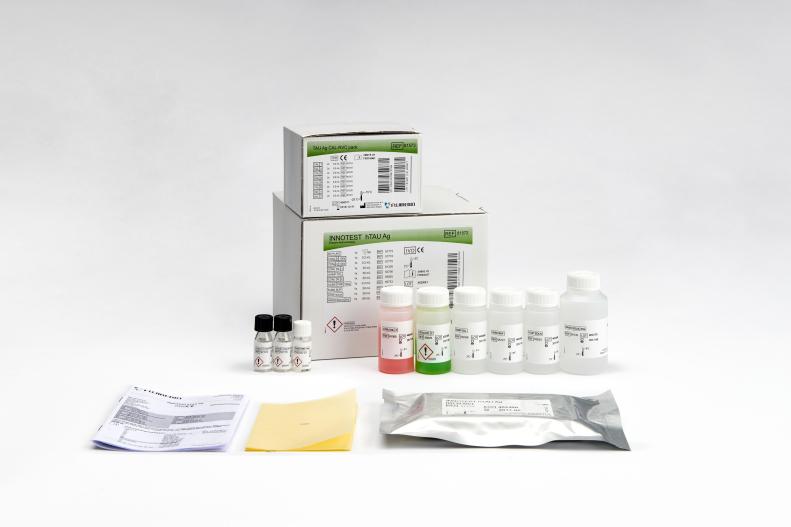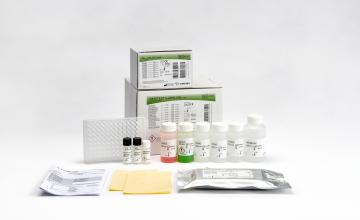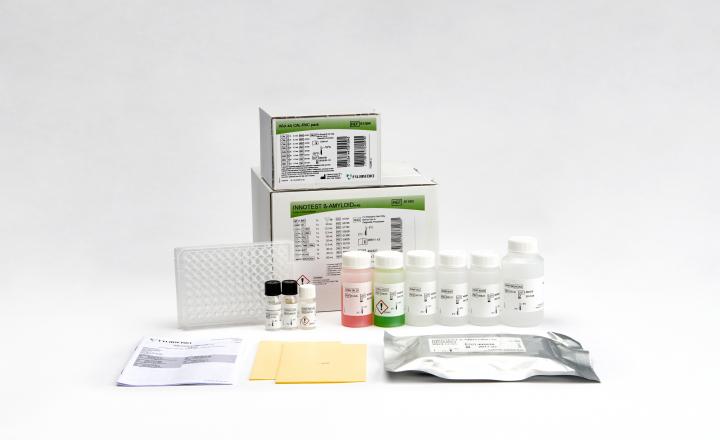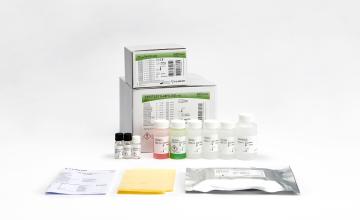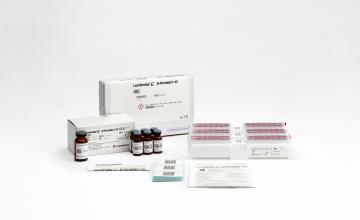INNOTEST® hTAU Ag
The INNOTEST hTAU Ag is a solid-phase enzyme immunoassay for the quantitative determination of Tau protein in human cerebrospinal fluid (CSF).
This assay measures the biomarker called total Tau, including the six isoforms (352 to 441 amino acids) from the brain.
The combined use of CSF-Tau and CSF-β-amyloid(1-42) marker concentrations allows differentiation between Alzheimer’s disease (AD) and normal aging or other neurological diseases such as depression (1-6).
Product number 81572
Product number 81573
Click here to navigate
- Contact sales for information
- Details
- Conditions of sale
- Citations
- Documentation
- Insights
- Product inquiry
- Related products
- Webinars
-
Details
Features & Benefits
- User-friendly enzyme immunoassay, standard technology
- Generic and color-coded components
- Easily automated on microplate processor (generic components)
- Ready-to-use Calibrators reduce inter and intra run variation
- Run Validation Controls for assay run validation
- Small sample volume: 25 µL CSF. Duplicate testing is strongly recommended and requires 2 x 25 µL CSF.
- Limit of Detection: 34 pg/mL
Calibrator range: 50 to 2500 pg/mL - This assay should be used in combination with the Tau Ag CAL-RVC pack, article no. 81573.
References- Andreasen et al. Evaluation of CSF-tau and CSF- Aβ42 as diagnostic markers for Alzheimer’s disease in clinical practice. Arch Neurol 2001;58:373-379.
- Sunderland et al. Decreased b-amyloid1-42 and Increased Tau Levels in Cerebrospinal Fluid of Patients With Alzheimer disease. Journal of the American Medical Association 2003;289:2094-2103.
- Hansson et al. Association between CSF biomarkers and incipient Alzheimer’s disease in patients with mild cognitive impairment: a follow-up study. Lancet Neurol 2006; 5: 228-234.
- Mattsson et al. CSF biomarkers and incipient Alzheimer disease in patients with mild cognitive impairment. JAMA 2009; 302(4): 385-393.
- Tabaraud et al. Alzheimer CSF biomarkers in routine clinical setting. Acta Neurol Scand. 2012; 125(6): 416-23.
- Buchhave et al. Cerebrospinal fluid levels of β-amyloid 1-42, but not of tau, are fully changed already 5 to 10 years before the onset of Alzheimer dementia. Arch Gen Psychiatry 2012; 69(1): 98-106.
Additional useful information about Alzheimer’s disease can be found on the following websites:
The Alzheimer forum site:
-
Conditions of sale
To read the end user conditions of sale for this product please visit our Resource center.
-
Citations
The BIOZ badges associated with Fujirebio products include peer-reviewed citations derived from scientific studies using Fujirebio products. Please note that the peer-reviewed citations do not reflect the regulatory status of Fujirebio products. Users should refer to the specific product documentation and any (clinical) claims made therein in order to ensure compliant use. For each country or geographic region, users must verify the related regulatory status of the Fujirebio product.
-
Documentation
Browse regulatory documents for this product
Create a (free!) eServices account and start browsing all product documentation right away.
Multimedia
Watch product videos
Get a (free!) eServices account and benefit from full access to all our online resources.
Other documents
FilePractical guide for lumbar puncture.pdf (pdf, 263.94 kb)FileNeuroSig v6-0 macro for use with INNOTEST Neuro assays (octet-stream, 214.10 kb)Get access to this section and more
Create a free eServices account now and instantly access multiple digital resources:
- Product documentation
- Selected scientific posters
- Product leaflets
- How-to videos and more…
-
Insights
Jul 23, 2025Fujirebio introduces its Neuro Expert Toolbox (NExT) at AAIC 2025
Fujirebio is introducing its Neuro Expert Toolbox (NExT) for the first time at AAIC 2025 (Alzheimer's Association International Conference®) in...
Nov 13, 2024Video - Alzheimer's awareness redefined
Follow the journey of the Sullivan family and leading Alzheimer’s Neurologist and Researcher Dr. David Greeley as they introduce and explain these...
Feb 20, 2024Publication - Serum and cerebrospinal fluid neurofilament light chains measured by SIMOA™, Ella™, and Lumipulse™ in multiple sclerosis naïve patients
We would like to draw your attention to a first publication on our Lumipulse® G NfL solution. In this article you will find a method comparison of CSF...
-
Product inquiry
-
Related products

